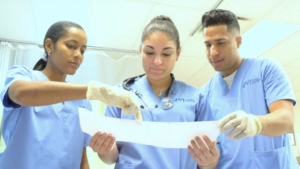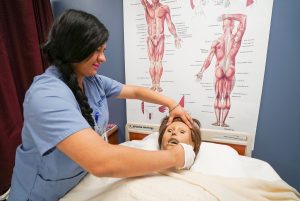
Medical Assistant students have a hands-on practice with Instructor Fabian Gonzales at the Miramar Campus.
Definition of Phlebotomy
According to the Merriam Webster Dictionary, Phlebotomy (plural phlebotomies) is:
The drawing of blood (as by venipuncture) for transfusion, apheresis, diagnostic testing, or experimental procedures
NOTE: Phlebotomy was once widely used to treat many types of disease but is now limited to the treatment of only a few conditions like hemochromatosis and polycythemia vera.
Phlebotomy Technicians: What do they do?
A Phlebotomy Technician draws quality blood samples from patients or blood donors and prepares those specimens for medical testing. Many patients have phobias when it comes to blood and needles and giving blood can be the most difficult part of an office visit. The phlebotomy technician must create an atmosphere of trust and confidence with patients while drawing blood specimens in a skillful, safe and reliable manner.
Phlebotomist Job Responsibilities
Phlebotomy technicians must like challenge and responsibility. They must also be accurate, work well under pressure and communicate effectively. Because they work directly with patients, they must notice and relay any important information gained during interactions to doctors, nurses and laboratory professionals. Typically, phlebotomy technicians are responsible for the following:
- Explaining procedures to patients
- Drawing blood and applying pressure or bandages after blood is drawn (see steps)
- Taking blood pressure, pulse and respiration readings
- Updating patient records
- Preparing stains and reagents
- Cleaning and sterilizing equipment
- Sending blood, urine and fecal samples to the lab for testing
Steps for a proper technique for a routine blood draw. A day of hands-on practice.
As a Florida medical assistant training program student and patient care tech training program student, one of the most common, yet complex procedures you’ll perform in a healthcare setting is drawing blood from a patient. This requires the knowledge and skills to assure the accuracy of the samples and to eliminate risk for both patient and healthcare professionals.
- The student starts by greeting the patient, identifying yourself, and asking the patient for two identifiers (name and date of birth) if he/she has followed the instructions given prior the procedure. Any questions? Then the student proceeds to wash hands, wear gloves and prepare all the equipment necessary to perform the procedure.
- After the alcohol pads, gauze, tape, needle, and required evacuated collection tubes are within reach, it is important to speak reassuringly to the patient as you position him/her for the draw.
- Apply a tourniquet, then use your fingertip to palpate the antecubital fossa to locate the Median Cubital Vein. Use an alcohol pad to cleanse the site in a circular motion. Let the area dry for 30-40seconds, reapply tourniquet. Grasp the patient’s arm firmly with your hand, placing your thumb proximally two inches below the intended puncture site. Aline the needle with the vein and inform the patient that you are ready to make the puncture.
- Position the needle bevel up in a 30-degree angle, then with a single short but firm motion insert the needle. Push in the evacuated tube onto the needle. A soon as the blood begins to flow into the collection tube, instruct the patient to open his/her arm and remove the tourniquet. Gentle mixing by inversion 6-8 times is required.
- After removing the tube, proceed to remove the needle, engage the safety device with one hand while placing a gauze applying pressure with the other one. Use the sharp device for proper disposal of the needle.
- Apply the ID label on the sample tubes ready to transport to the lab. The student must make sure the labels include the patient’s name, D.O.B, and today’s date. Dispense of all other used non-sharp materials, including gloves in an approved trash receptacle, and disinfect all contaminated surface areas.
Contact FVI admissions to speak to our specialists and get your patient care tech career or medical assistant career started today! FVI has a patient care tech school in Miami and medical assistant school in Miramar & Miami.










